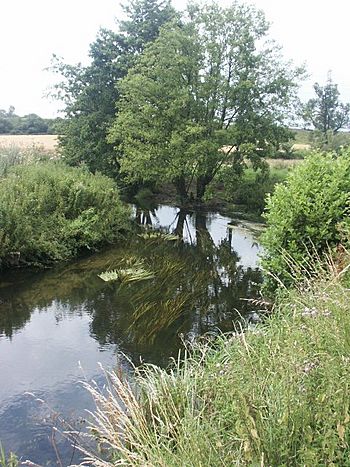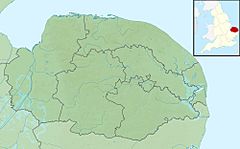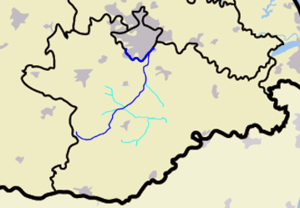River Tas facts for kids
Quick facts for kids Tas |
|
|---|---|

The river at Caistor St. Edmund
|
|
|
Location of the river mouth within Norfolk
|
|
| Country | England |
| Region | Norfolk |
| Physical characteristics | |
| Main source | Carleton Rode 51 m (167 ft) 52°29′06″N 1°06′08″E / 52.4849°N 1.1021°E |
| River mouth | River Yare Trowse 3 m (9.8 ft) 52°36′32″N 1°18′25″E / 52.6089°N 1.3069°E |
| Basin features | |
| River system | River Yare |
| Tributaries |
|
The River Tas is a small river in England. It flows north through an area called South Norfolk. This area is even named the Tas Valley, after the river! The River Tas eventually joins a bigger river, the River Yare, near Norwich.
Contents
Where the River Tas Flows
The River Tas starts from small streams. These streams begin near Hempnall and Carleton Rode. They then meet together at a village called Tasburgh.
From Tasburgh, the river flows through several villages. These include Newton Flotman and Smockmill Common. In a place called Shotesham Park, the river splits into two parts. These two parts join back together just before Shotesham ford. This spot is popular for paddling, swimming, and fishing in summer.
After Shotesham, the river continues north. It passes through Stoke Holy Cross, Dunston, Caistor St Edmund, Markshall, and Arminghall. Finally, it joins the River Yare at Trowse. This meeting point is just south of Norwich.
History Along the River Tas
The Tas Valley is full of interesting historical places. You can find an Iron Age hill fort at Tasburgh. An Iron Age hill fort is an ancient settlement on a hill, often surrounded by earthworks for defense.
There is also an old Roman town called Venta Icenorum. This town is now known as Caistor St Edmund. Another historical site is a woodhenge at Arminghall. A woodhenge is a circular monument made of wooden posts, similar to Stonehenge but with wood.
The mill at Stoke Holy Cross has a special history. It was the first place where Colman's mustard was made. This famous mustard business started right by the river.
The River in Roman Times
Long ago, when the Romans lived in England, the River Tas was much larger. It was a very important route for travel and transport. People living in the Roman town of Venta Icenorum used the river to move goods and people. Today, it is a smaller river that winds through farmland.
Wildlife in the River Tas
The River Tas is home to several types of fish. You can find roach and dace in its waters. Sometimes, you might even spot an occasional trout.
Smaller pike also live here. And you can find some chub. Anglers, who are people who fish, have caught some impressive fish in the Tas. For example, a large roach weighing about 2.6 pounds was caught in 1972. A dace weighing about 1.2 pounds was caught in 1943.



